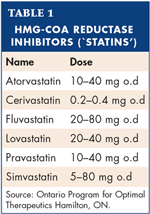Stable Coronary Artery Disease
D'Arcy Little, MD, CCFP
Director of Medical Education,
York Community Services, Toronto, ON.
Introduction
A recent, large, retrospective study concluded that anti-ischemic therapy in nursing home patients with coronary artery disease (CAD) is often suboptimal. When the medical regimens of 72,263 patients aged 65 years or older with a diagnosis of CAD were evaluated, beta-adrenergic blockers were the least likely anti-ischemic agent (of nitrates, calcium channel blockers and beta-adrenegic blockers) to be administered regardless of age, gender, cognitive or physical function.1 The following article will review the management of coronary artery disease in this population with the goal of providing the busy clinician with a practical, evidence-based approach.
 Epidemiology
Epidemiology
Coronary artery disease is a major clinical problem in the elderly,2 and the prevalence is increasing as the population ages.4 It is the leading cause of death in Canada, responsible for 56% of deaths related to cardiovascular disease, and 21% of all deaths.3 The incidence of CAD increases significantly in both sexes above the age of 65 years.

 Epidemiology
Epidemiology